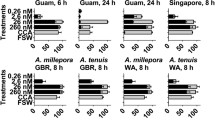Abstract
Lipophilic inducers of larval settlement and metamorphosis of Pseudocentrotus depressus and Anthocidaris crassispina, two commercially important sea urchin species in Japan, were isolated from the foliose coralline red alga Corallina pilulifera (collected in 1990 near Saga, Japan) and identified. Larval assays of the fractions obtained by silica gel column chromatography of the total lipids showed that non-polar groups of lipids were effective at inducing larval settlement and metamorphosis. The effective fractions were further subjected to gel filtration (Sephadex LH-20) and also to silica gel column chromatography, and the effective components isolated as single spots by thin-layer chromatography. The components at a concentration of ca. 0.4 mg paper-1 (sample was adsorbed on a paper with 20 cm2) induced high rates of larval settlement of both P. depressus and A. crassispina. Chemical analyses of the components revealed a mixture of free fatty acids (FFAs), dominated by eicosapentaenoic acid (20:5, 41 to 50%), palmitic acid (16:0, 11 to 17%), arachidonic acid (20:4, 9 to 15%), and palmitoleic acid (16:1, 4 to 5%). In assays with the four standard FFAs, only 20:4 and 20:5 induced larval settlement and metamorphosis of the two species, while 16:0 and 16:1 were ineffective. The larvae underwent significant rates of settlement and metamorphosis in response to the two former FFAs at levels as low as 0.18 mg paper-1. Amongst the free fatty acid components of the alga, 20:5 was isolated as the chemical inducer of larval settlement and metamorphosis of the sea urchins in the laboratory.
Similar content being viewed by others
Literature cited
Cameron, R. A., Hinegardner, R. T. (1974). Initiation of metamorphosis in laboratory cultured sea urchins. Biol. Bull. mar. biol. Lab., Woods Hole 146: 335–342
Cameron, R. A., Schroeter, S. C. (1980). Sea urchin recruitment: effect of substrate selection on the juvenile distribution. Mar. Ecol. Prog. Ser. 2: 243–247
Folch, J., Lees, M., Stanley, G. H. S. (1957). A simple method for the isolation and purification of total lipids from animal tissues. J. biol. Chem. 226: 497–509
Gonzalez, L. P., Castilla, J. C., Guisado, C. (1987). Effect of larval diet and rearing temperature on metamorphosis and juvenile survival of the edible sea urchin Loxechinus albus (Molina, 1782) (Echinoidea, Echinidae). J. Shellfish Res. 6: 109–115
Ito, S., Ariyoshi, T., Ito. Y. (1985). Mass production of Chaetoceros gracilis. A. Rep. Saga Pref. Sea Farming Cent. 97–103 (in Japanese)
Ito, S., Kobayakawa, J., Tani, Y., Nakamura, N. (1991). The combined effect of Hizikia fusiformis with attaching diatoms for larval settlement and metamorphosis of Hemicentrotus pulcherriums and Pseudocentrotus depressus. Saibaigiken 19: 61–66 (in Japanese)
Ito, Y. (1984). The effect of benthic diatom on the acceleration of the metamorphosis of sea urchin larva. Mar. Fouling 5: 15–18 (in Japanese)
Ito, Y., Ito, S., Kanamaru, H., Masaki, K. (1987). Dietary effect of attaching diatom Navicula ramosissima on mass production of young sea urchin Pseudocentrotus depressus. Nippon Suisan Gakk. 53: 1735–1740 (in Japanese, English abstract)
Kato, T., Kumanireng, A. S., Ichinose, I., Kitahara, Y., Kakinuma, Y., Nishihira, M., Kato, M. (1975). Active components of Sargassum tortile effecting the settlement of swimming larvae of Coryne uchidai. Experientia 31: 433–434
Keck, R., Maurer, D., Kauer, J. C., Sheppard, W. A. (1971). Chemical stimulants affecting larval settlement in the American oyster. Proc. natn. Shellfish. Ass. 61: 24–28
Kitamura, H., Kitahara, S., Hirayama, K. (1992). Lipophilic inducers extracted from Corallina pilulifera for larval settlement and metamorphosis of two sea urchins (Pseudocentrotus depressus and Anthocidaris crassispina). Nippon Suisan Gakk. 58: 75–78
Pawlik, J. R. (1986). Chemical induction of larval settlement and metamorphosis in the reef-building tube worm Phragmatopoma california (Sabellarridae: Polychaeta). Mar. Biol. 91: 59–68
Pearce, C. M., Scheilbling, R. E. (1990). Induction of metamorphosis of larvae of the green sea urchin. Strongylocentrotus droebachiensis, by coralline red algae. Biol. Bull. mar. biol. Lab., Woods Hole 179: 304–311
Pearce, C. M., Scheibling, R. E. (1991). Effect of macroalage, micorbial films, and conspecifics on the induction of metamorphosis of the green sea urchin, Strongylocentrotus droebachiensis (Müller). J. exp. mar. Biol. Ecol. 147: 147–162
Rowley, R. J. (1989). Settlement and recruitment of sea urchins (Strongylocentrotus spp.) in a sea-urchin barren ground and a kelp bed: are populations regulated by settlement or post-settlement processes? Mar. Biol. 100: 485–494
Tani, Y., Ito, Y. (1979). The effect of benthic diatoms on the settlement and metamorphosis of Pseudocentrotus depressus larva. Suisan-Zoshoku 27: 148–150 (in Japanese)
Author information
Authors and Affiliations
Additional information
Communicated by T. Ikeda, Niigata
Rights and permissions
About this article
Cite this article
Kitamura, H., Kitahara, S. & Koh, H.B. The induction of larval settlement and metamorphosis of two sea urchins, Pseudocentrotus depressus and Anthocidaris crassispina, by free fatty acids extracted from the coralline red alga Corallina pilulifera . Marine Biology 115, 387–392 (1993). https://doi.org/10.1007/BF00349836
Received:
Accepted:
Issue Date:
DOI: https://doi.org/10.1007/BF00349836




